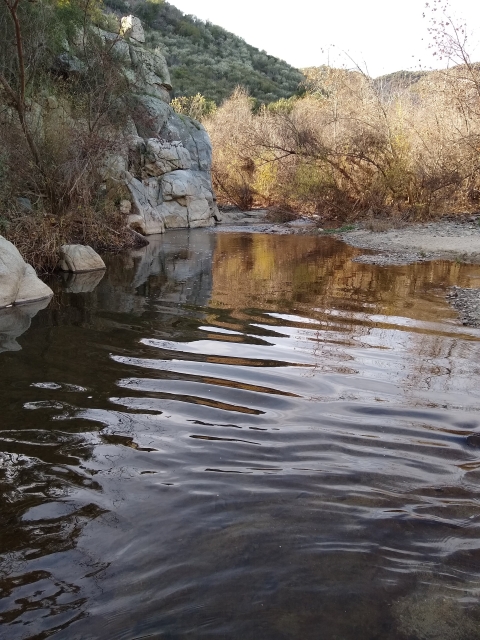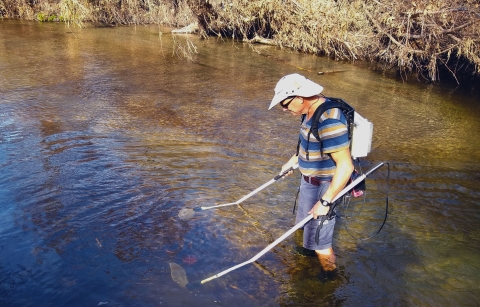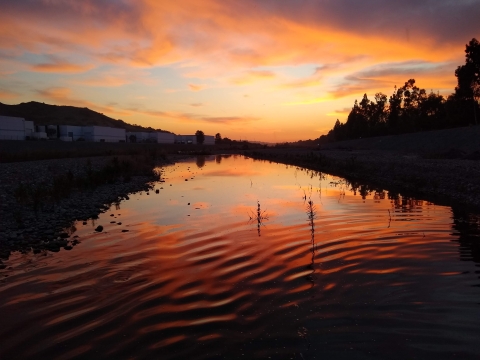“They will recolonize, if we pave the way for them,” said Damon Goodman, former biologist with the U.S. Fish and Wildlife Service’s Arcata office who is now a regional director in Northern California for CalTrout. If this sounds similar to the Field of Dreams famous quote: “if you build it, they will come,” it is. And it is exactly what happened with Pacific lamprey recolonizing in the Santa Margarita River in Southern California.
Found in the river in August 2019 for the first time since last documented in 1940, this is now the furthest south the species has currently recolonized, 260 miles south of the previous location in San Luis Obispo which recolonized in 2017. These results were confirmed again in 2020 and 2021 – this followed unsuccessful efforts in the 1990s, 2005 and 2014 without locating a single lamprey.
Dr. Stewart Reid, from Western Fishes believes that the key to their return was a recent high flow event combined with a rebuilt weir and new fishway at Camp Pendleton which allowed the lamprey to find passage into the river.
“I want to give credit to the Marine Corps for putting in the fish ladder,” said Reid. “It may very well have played a role in an easier pathway for the lamprey to get into the river.”
In addition to the fish passage fish passage
Fish passage is the ability of fish or other aquatic species to move freely throughout their life to find food, reproduce, and complete their natural migration cycles. Millions of barriers to fish passage across the country are fragmenting habitat and leading to species declines. The U.S. Fish and Wildlife Service's National Fish Passage Program is working to reconnect watersheds to benefit both wildlife and people.
Learn more about fish passage system or ladder installed in 2019 to aid steelhead, the U.S. Marine Corps which manages the river on Camp Pendleton, took steps to remove invasive species invasive species
An invasive species is any plant or animal that has spread or been introduced into a new area where they are, or could, cause harm to the environment, economy, or human, animal, or plant health. Their unwelcome presence can destroy ecosystems and cost millions of dollars.
Learn more about invasive species such as black bass, crayfish, common carp, catfish, mosquito-fish and American bullfrogs as a part of the National Marine Fisheries Service federal recovery plan.
“It is a good indicator that our resources management efforts are working here at Camp Pendleton,” said U.S. Marine Corps Fish Biologist and Aquatic Species Specialist for Coastal and Riparian Ecosystems, Kathryn Carmody, of the lamprey coming back. “I think it points a lot to our widespread aquatic exotic control that is a huge issue throughout watersheds in Southern California. Since 2004 really being able to target all of our invasive species and remove as many as we can has really helped native species to be able to survive in these watersheds again and contribute to the health of the watershed.”
Goodman agreed that the Marine Corps’ efforts contributed greatly. “What we are finding is when the conditions are right, they’ll be there,” he said. “They have the ability to recolonize if they find a route to occupy historical habitats.
“To see them back in the river was a great moment. This is a major milestone toward recovery of Pacific lamprey here in California.”
Goodman and Reid plan to work with the Marine Corps to consider a low-cost lamprey friendly system similar to what was installed at Van Arsdaledam on the Eel River with four-inch flexible tubing, where biologists are able to count the numbers by using a camera; or another system such as a simple ‘open climbing wall’ might be considered.
“We’re supportive of their efforts on base (Camp Pendleton) to provide fish passage, especially on the Santa Margarita River, which is a core population - one of the highest priorities as designated in the NMFS federal recovery plan for southern steelhead as part of that group,” said Sandra Jacobson, a CalTrout regional director for Southern California and the Sierras and a member of the South Coast Steelhead Coalition.
“Lamprey have not been found in any Southern California freshwater system in recent years, and to show up consistently for multiple years here shows us that the Santa Margarita is capable of supporting this species now, where before maybe it wasn’t,” said Carmody.
“The potential is there all across the marine ecosystem in Southern California,” said Reid of lamprey’s presence. “We just need to build it (passage) and they will come.”
Incorporating lamprey habitat and passage requirements into river management is critical for enabling recovery. Working side-by-side with partners that manage our rivers such as the Marine Corps, tribes, universities, communities, California Department of Fish and Wildlife and other local, state and federal agencies is absolutely key to the species making a comeback per Goodman.
This work has been ongoing for several years for Goodman, Reid and many others.
A recent study by Goodman and Reid found that the duration of the ammocoete – or larval lamprey life stage is not well understood, hampering the development of lamprey conservation strategies. Goodman, Reid and other partners monitored the anadromous Pacific lamprey in the San Luis Obispo drainage near the southern extent of their range from hatch to transformation into macrophthalmia, the life stage where they move out to sea for feeding. Lamprey had been absent for over six years, but naturally recolonized, with ammocoetes first detected in 2017. They found that in the warm south ammocoetes matured more quickly than in more widely studied northern populations, shortening their freshwater residency.
Ammocoetes transformed into the older life stage (macrophthalmia) in as little as 2.6 years - at least half that assumed in other studies. This is the first estimate of time-to-transformation for lamprey in its southern range and provides insights into adaptive strategies and refinement of recovery approaches for the lamprey species worldwide.
“I appreciate all his work with lamprey to date,” Carmody said of Goodman, “because lamprey is not listed yet, they don’t get the necessary resources, so it is nice to know we have people like him out there monitoring and putting in the effort, so we have more data.”
“We can’t solve these problems without looking,” said Reid of his and Goodman’s efforts to continue to check watersheds across Southern California in the hopes they will find them again. “We monitor populations thinking in terms of conservation. Some say, well, they’ve disappeared from Southern California – we’ve lost the species. I say let’s try to understand their biology and the characteristics of their historical habitat. The peripheral habitat in the range of a species tends to sort of expand and contract. So, the key is we want to keep our hopes up, keep habitat and pathways open, and not panic.”







